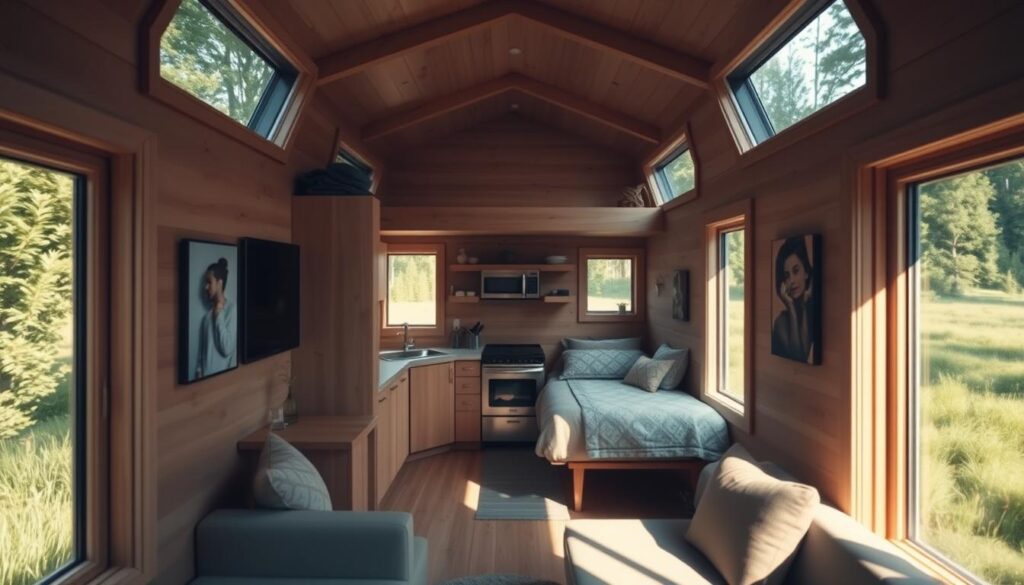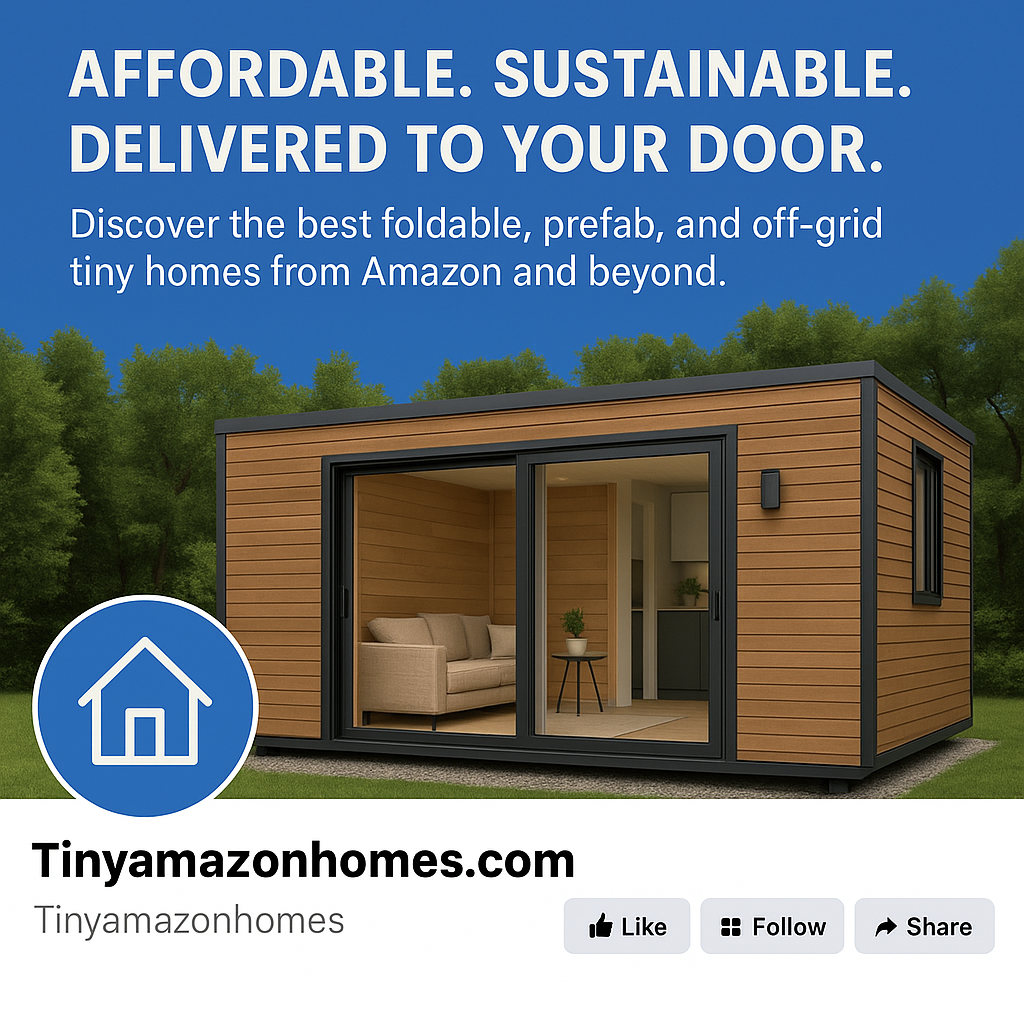The tiny home movement is changing how we see living spaces. There are about 10,000 to 12,000 tiny homes in the U.S. This trend is growing as a good choice for affordable and green housing.
More people want to save money and help the planet. Compact living is becoming more popular. Downsizing to a tiny home means lower bills, less waste, and a simpler life.
If you’re interested in the tiny house movement, there’s help available. Check out tinyamazonhomes.com to learn more about joining the compact living revolution.
Key Takeaways
- The tiny home movement offers an affordable housing option.
- Compact living reduces environmental impact.
- Tiny homes promote a simpler lifestyle.
- The trend is gaining popularity across the United States.
- Resources are available for those looking to transition to tiny home living.
The Evolution of Tiny Homes in America
The tiny house movement in America has grown a lot. It started with simple ideas and has evolved over time. Today, it’s a big part of our culture.
Historical Roots of the Small House Movement
The tiny house movement began in the 1960s and 1970s. It was inspired by Henry David Thoreau and the back-to-the-land movement. People wanted simpler lives and to be more self-sufficient.
Thoreau’s simple life at Walden Pond inspired many. He showed that living with fewer things and being close to nature is possible.
Pioneers and Influential Designers
Today, designers like Jay Shafer are leading the tiny house movement. They make tiny homes on wheels popular. Groups like Tiny House Swoon also inspire people with their designs.
For more info on tiny home designs, check out tinyamazonhomes.com.
Current Trends and Future Projections
The tiny house movement is getting bigger. People want financial freedom and to help the environment. We’ll see more focus on being green and living in communities.
| Trend | Description | Impact |
|---|---|---|
| Sustainable Materials | Increased use of eco-friendly materials in construction | Reduced environmental impact |
| Community Living | Development of tiny house communities | Enhanced social connections |
| Innovative Designs | Advancements in tiny house design and functionality | Improved quality of life |
The tiny house movement will keep growing. We’ll see even more new ideas and designs. This will shape the future of small house living in America.
Benefits of Embracing Minimalist Living
Living minimally can change your life for the better. It makes your living space simpler and your life more fulfilling. You’ll see improvements in your finances, the planet, and your mind.
Financial Freedom and Reduced Living Costs
Minimalist living can make you financially free. Downsizing and buying less means spending less on things like utilities and homes. Tiny homes, for example, are much cheaper than big houses.
| Expense Category | Traditional Home | Tiny Home |
|---|---|---|
| Mortgage/Rent | $1,500/month | $500/month |
| Utilities | $200/month | $100/month |
| Maintenance | $500/year | $100/year |
The table shows tiny homes cost less. This leads to more money in your pocket and lower living costs.
Environmental Benefits and Reduced Carbon Footprint
Living minimally is also good for the planet. Smaller homes use fewer resources, which means less harm to the environment. Tiny homes often use green materials and save energy too.
Eco-friendly features common in tiny homes include:
- Solar panels for renewable energy
- Recycled materials for construction
- Energy-efficient appliances
- Composting toilets and greywater systems
These features help reduce harm to the environment. They also support a greener lifestyle.

Mental Clarity and Simplified Lifestyle
Minimalist living also brings mental clarity. By owning less, you focus on what’s truly important. This can make you feel free and clear-minded.
“Living in a tiny home has given me the freedom to pursue my passions without the burden of a large mortgage or excessive expenses.” – Tiny home dweller
By living minimally, you can have a life that’s simpler and more meaningful. It’s about valuing what’s important and living in a way that’s true to you.
Exploring Different Types of Tiny Homes
Tiny homes come in many forms. They suit different lifestyles and tastes. You can find everything from traditional homes to mobile dwellings. This variety is key to the tiny home movement, offering choices for downsizing and simplifying life.
Foundation-Based Small Houses
Foundation-based small houses are popular for their stability. They are built like regular houses but are much smaller. They have access to utilities like water and electricity, making them comfortable.
Benefits include a sense of community and stability. They also offer access to parks and local services. But, they lack the mobility of other tiny homes.
Tiny Homes on Wheels (THOWs)
Tiny Homes on Wheels (THOWs) are a symbol of the tiny home movement. They are built on trailers, making them mobile. This appeals to those who love to travel or move often.
Key advantages include the freedom to change locations and lower costs. But, finding parking and dealing with zoning laws can be tough.
Converted Shipping Containers and Buses
Converted shipping containers and buses are for the adventurous. They turn these containers or buses into homes, often with a simple design. This is an eco-friendly and cost-effective option.
Advantages include being good for the environment and saving money. But, they need special skills to convert and keep up.
“The tiny house movement is not just about downsizing; it’s about living more intentionally and sustainably.”
Urban Micro Apartments and Accessory Dwelling Units
Urban micro apartments and accessory dwelling units (ADUs) fit into the city. Micro apartments are small but efficient. ADUs are secondary homes on the same property, like cottages or garage conversions.
Benefits include being close to city amenities and earning rental income. But, they can be hard to set up due to zoning laws.
For more on tiny homes, check out tinyamazonhomes.com. It offers insights and ideas for your tiny home adventure.
Smart Design Principles for Compact Living
Smart design is key for making the most of small living spaces. Tiny home residents can enjoy both function and style. They can also have a lot of space.
Maximizing Vertical Space
Maximizing vertical space is a big part of living small. Loft beds and storage units that go up to the ceiling help. Wall-mounted furniture also works well.
Using the vertical space keeps the floor open. This makes the space feel bigger and easier to move around.
Multi-Functional Furniture Solutions
Multi-functional furniture is a smart choice for tiny homes. Sofa beds and storage ottomans are great examples. They serve more than one purpose.
This reduces clutter and makes the space more useful. It’s a clever way to use every inch.
Innovative Storage Strategies
Innovative storage is crucial in small spaces. Hidden compartments and under-bed storage are good ideas. They help keep things organized.
For more storage ideas, check out tinyamazonhomes.com.
Creating Visual Spaciousness Through Design
Creating a sense of space is not just about size. It’s also about how it looks. Light colors and mirrors can make a small home feel bigger.
Using transparent or translucent materials also helps. It makes the space feel more open.
| Design Principle | Benefit | Example |
|---|---|---|
| Maximizing Vertical Space | Increases storage and living area | Loft beds, wall-mounted shelves |
| Multi-Functional Furniture | Reduces clutter, increases functionality | Sofa beds, storage ottomans |
| Innovative Storage | Enhances organization and space | Hidden compartments, under-bed storage |
Navigating Legal Challenges of the Tiny House Movement
Living in a tiny house is more than just wanting to live simply. You need to know the law. As the tiny house movement grows, so do the legal hurdles.
Understanding Zoning Regulations by Region
Zoning laws change a lot from place to place. It’s key for tiny home owners to know the laws in their area. Some places welcome tiny homes more than others.
- Check local zoning laws before getting a tiny home.
- Know the difference in zoning for tiny homes on wheels and those on foundations.
- Join local groups to keep up with zoning changes.
Parking, Land Use, and Utility Hookups
Finding a spot for your tiny home can be tough. There are rules on land use and hookups needed. Compact living fans need to think about these when planning.
Here are some ways to solve these problems:
- Look into tiny home communities with parking and services.
- Check out private land for tiny homes, making sure it follows local rules.
- Learn what hookups you need, like water and electricity.
Financing, Insurance, and Resale Considerations
Getting a loan for a tiny home is harder than for regular houses. Insurance might be hard to find too. For help, tinyamazonhomes.com is a great resource.
Important things to think about are:
- Look for loans made just for tiny homes.
- Find insurance for tiny homes, knowing it might be hard.
- Think about how easy it will be to sell your tiny home later.
Knowing and tackling these legal issues helps you enjoy the tiny house movement and compact living.
Building vs. Purchasing Your Tiny Home
When thinking about tiny home living, you must choose between building or buying. Each choice has its own good points and bad points. These include how much it costs, how flexible the design can be, and how much it’s worth later.
Building your tiny home lets you make it exactly how you want it. This means you can design it to fit your needs perfectly. But, it takes a lot of time, effort, and knowledge. Buying a tiny home is easier because you don’t have to deal with building it. Companies like Tiny Amazon Homes sell pre-made tiny homes that are ready to go.
Whether to build or buy a tiny home depends on what you value most. By looking at the good and bad of each choice, you can pick what’s best for you. This choice helps you live in a small space while still having what you need.
For more details on building or buying a tiny home, check out tinyamazonhomes.com. They have lots of information and options to look at.
